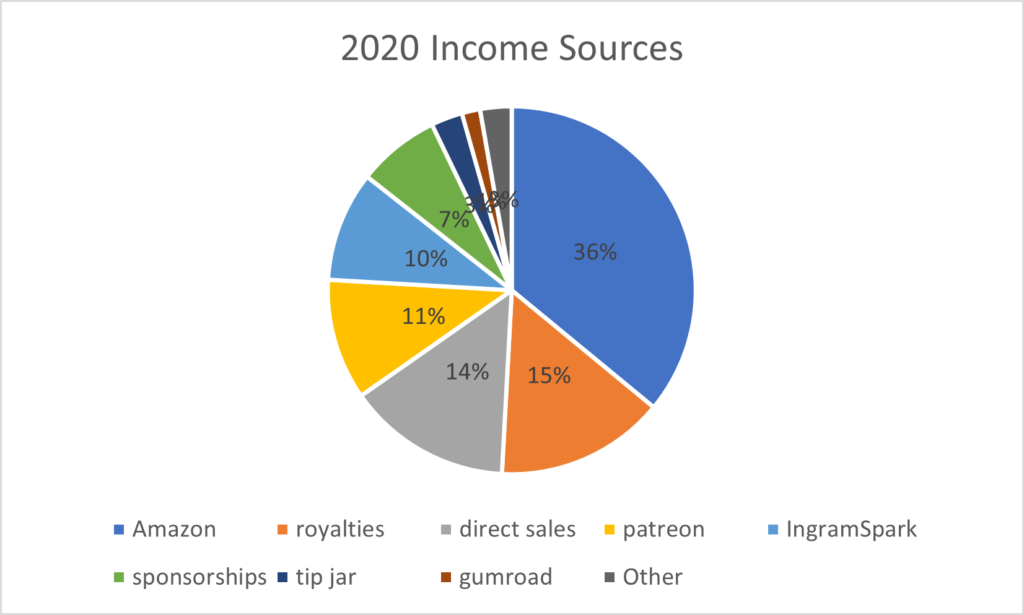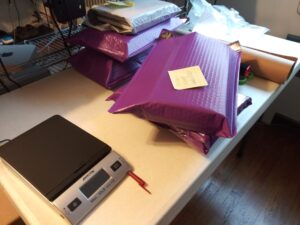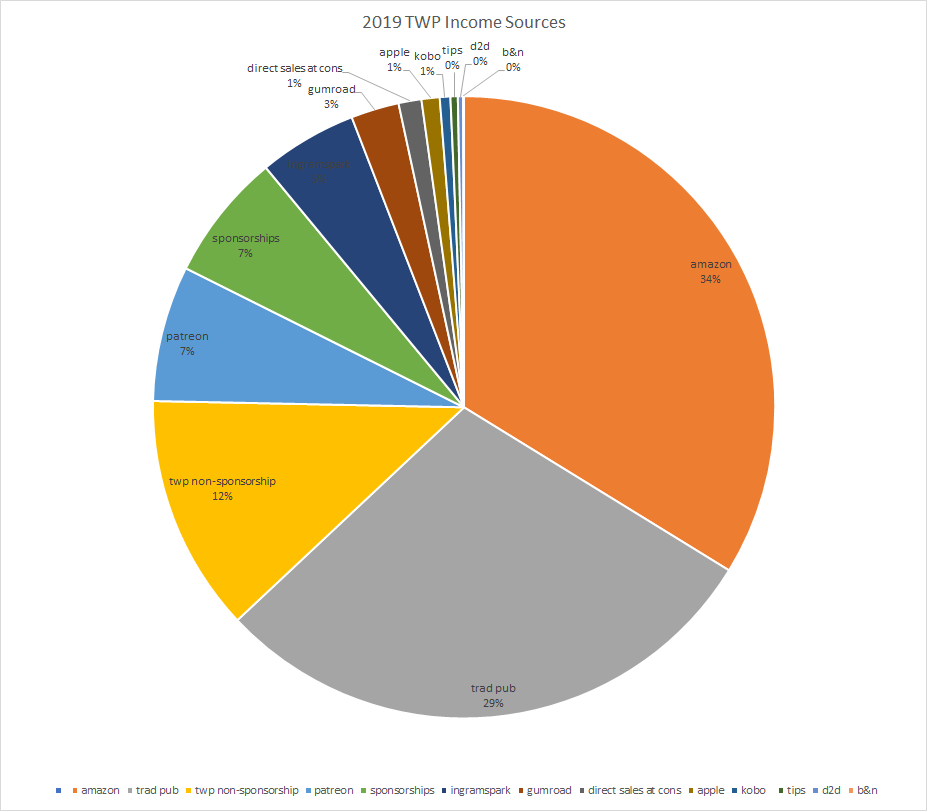I’ve had to explain this in two separate conversations, to folks I thought already understood it, so it’s time for a blog post about the business of paper books.
Beware: publishing industry neepery ahead. This is mainly aimed at folks who started off in self-pub and previously didn’t need to know the inside details of the book trade, so they’re missing out on options. I’m giving a high level overview here: this industry has evolved for centuries and is not this tidy.
The book trade has four main parts.
Authors write books, and license that intellectual property to a publisher.
Publishers produce physical books. They might pay a printing company to run thousands of copies, or use a print on-demand-facility.
If you’re a self-publisher, you are both the author and the publisher in this discussion. You wear both hats at separate times.
Retailers sell books to readers. This might be the general public, university students, or any other group. Retailers have the job of picking which books they will stock and attracting customers.
For a publisher to ship 1-2 copies of a book to each bookstore that wants them is cost-prohibitive, both in staff time and shipping cost. That’s where distributors come in. Distributors order a publisher’s books in bulk. Bookstores order books in bulk from a distributor, but those orders contain books from many publishers. The distributor breaks up one bulk order, stores them, and cost-effectively fills bookstore orders.
Some organizations own multiple parts of this chain. Penguin Random House is a huge publisher. They also own a distributor called, conveniently enough, Penguin Random House. (Why they didn’t go with Randy Penguin, flinging their treasures everywhere, I’ll never know.) Barnes & Noble owns a distributor and a publisher. Amazon is both a distributor and a retailer. (They even have a trad publishing arm that publishes some of the books they sell.)
The publisher sets a book’s cover price. Let’s say the cover price is $10, because that makes my math easy. The publisher sells the print book to a distributor for a percentage of the cover price. The exact percentage varies based on contractual agreements. For my examples I’m going to go with 40% for the publisher, 20% for the distributor, and 40% for the retailer. They make my math easy, and they’re also the numbers used by Amazon’s KDP Print program.
So the publisher gets paid $4 for a $10 book. Out of that $4 the publisher must pay to print the book, ship the book to the distributor, pay the staff, boozy lunches, and (presumably) pay the author. Eventually.
The distributor gets $2. Out of this they pay for warehousing, unboxing books, taking orders, reboxing books, and notably sybaritic boozy lunches.
The bookstore gets $4 of that. They pay shipping on their orders, plus clerk salaries and rent and all that boring physical stuff. It’s expensive, but there might be a box of wine at Christmas.
Anyone along this chain can discount the book by taking a smaller cut.
As an author, you get a chunk of the publisher’s take. The amount varies from 1% minus printing costs to 25% of the gross, depending on the drawing power of your name, how drunk you can get the publisher during negotiations, and how business looked when your contract was signed. Because I’m too lazy to do real math, I’m going to assume that your devoted study of the Munich Handbook of Necromancy paid off and you have a 50% split of the publisher’s gross.
The financial split looks somewhat like this. Green is money you get. Yellow is money other people earn. Red is where you get no share in the process, because you don’t participate in that level of the business.

Your publisher pays you $2 for the sale of your $10 book. (Again, this is very high. Nobody really gets paid this much by a trad publisher.)
Easy and effective self-publishing changed the distribution of funds. Authors could get the entirety of the publisher’s cut, if they were willing to do the work.

You get $4, but you must pay for producing the book. All print-on-demand companies will tell you how much your book costs to print, so that’s easy. You also must pay for cover art, copyediting, and so on. Will you come out ahead here? That’s a question for you and your calculator.
Now let’s consider distribution. A book goes through the publisher and the distributor to the retailer.
The previous chart also represents what happens when a bookstore buys a print book published through Amazon. It’s Amazon’s Expanded Distribution. What if the retailer is Amazon? Amazon doesn’t take a distributor cut; they pay the full 60%.

You get $6, minus production costs.
Amazon has decided that they’ll skip taking a cut of distribution if they can get that 40% for handling the retail end. There’s no risk on their end; they don’t have to even physically stock the book until someone pays for it.
This is why Expanded Distribution pays so much less than Amazon direct; you’re losing out on that extra 20% of retail. If producing your book costs $3, a $6 sale nets you $3. A sale to a bookstore, routed through Expanded Distribution, nets you $1.
But now, consider IngramSpark. IS has an assortment of fees that muddy this model, and they let you adjust the percentage discount retailers get on your book, but let’s stick with the 40/20/40 split for now. It’s close enough. Effectively, you wind up with the publisher share and a piece of the distributor share.

Sell a $10 book to a bookstore via Amazon, you gross $4. Sell a book to a bookstore via IngramSpark, you gross $5.
That might not sound like a huge difference, but suppose your book costs $3 to produce. A sale via Amazon nets you $1, IS nets $2. That “margin” thing business folks babble about? This is it. Over hundreds or thousands of sales, margin adds up.
Part of this graph hasn’t changed. That’s the retailer, over on the far right hand side. I am unwilling to handle direct mail orders.
But there’s options for that, now. Enter Aerio. Aerio lets anyone set up an online store for print books. I’ve done it. It works.
Aerio splits the retail portion of the sale with the store owner. As a traditionally published author selling my books through Aerio, the income looks like so.

That’s $4 for me, and I don’t have to pay to print the book. Note that the author’s royalty I used in this example is way, way high; no publisher pays 50% on print books. For most trad-pubbed authors, an Aerio sale will net them far more than their royalty.
If you’re a self-pubbed author distributing books via Amazon’s Expanded Distribution, the money looks nicer.

I have to pay for printing the book, but that $6 net is a lot nicer to start from than $4.
The Big Prize with Aerio, though, is when you sell books available through IngramSpark.

This is a pretty chart. I like this chart. I want to buy it dinner and flowers. If I can’t do okay grossing $7 on a $10 book, I don’t deserve to be an author.
And truth is, I’m delighted to pay Ingram their cut to produce the book and Aerio a cut to provide a spiffy web site and ship the book. These jobs give me splenic hives.
As an author, always look where the money’s being made. See how you can get a cut of it.
One note on using Aerio: Most author/small publisher accounting software, like TrackerBox, view the author’s income from different sources as a single sale. You sold a book to channel X, where X is “Amazon direct” or “Expanded Distribution” or “trad pub.” Aerio breaks this. Aerio is a retailer. They buy from a distributor. Each Aerio sale shows up once as a sale from Aerio, and also on your IngramSpark or Amazon report. You sold 100 print copies of Great Novel on Amazon Expanded Distribution, and 15 on Aerio? That’s not 115 copies. That’s 100 copies. You get paid via two different channels on 15 of them.
As far as I’m concerned, the only way to improve on the Aerio model is for someone to help me transparently offer print/ebook bundles globally. I would happily offer buyers of print books the ebook version for free. Help me do that, and I and my readers will flock to you.
So, uh: I have a print bookstore. You can buy many of my books directly there, in both hardcover and paperback. I make more off those sales than anywhere else. If you want print books, and you want to give me a bigger cut of the sale, buy there.











